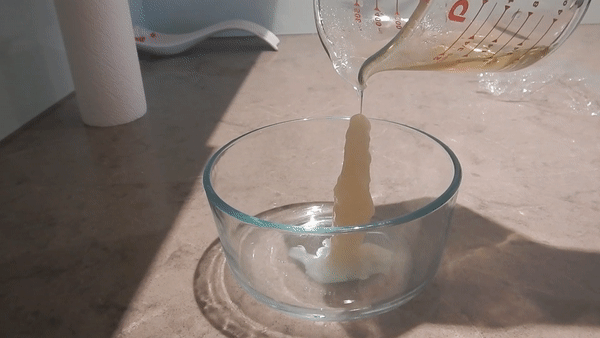This can be a bit of a tricky experiment, but when it works, it’s fantastic! Combine vinegar and baking soda to make ‘hot ice’. Warning: boiling water involved #adultsupervision
What you need:
Vinegar, baking soda, saucepan, jug, bowl
What to do:
- Put 4 cups (1 L) of white vinegar into a saucepan. Then slowly add 3 tablespoons (60 mL) of baking soda, not letting the pot bubble over.
- Heat the saucepan on the stove and boil the solution. You want to remove most of the water from the mixture, until the solution is reduced to about 100 mL. This may take about an hour. It is ready when a thin crystal film starts to form on the surface of the liquid. If this film starts to form and you have too much liquid, add extra vinegar to react with excess baking soda.
- As soon as the solution is ready, pour it into an empty jug, cover it to prevent further evaporation, and put it in the fridge to cool to room temperature or below (which should take about an hour). The solution should be clear and might be yellow. If there are crystals in the jug, they should be removed or dissolved before cooling. Stirring or adding a tiny bit of extra vinegar can help dissolve crystals while the solution is still hot.
- As the saucepan cools, the residue left on the bottom should crystallise. Scrape out the crystals and put them in a dish or container for later use.
- Put a single crystal in the bottom of a dish. Carefully take the jug and slowly pour it onto the crystal. The solution should spontaneously crystallise. If you pour slowly and carefully you can make a tower.
- Once the solution has crystallised, it can be melted by heating it in the microwave, preferably in a covered container to prevent evaporation. The liquid can then be cooled and you can continue to play around with crystallisation.
Safety
- This experiment involves boiling water and using a stove. Adult supervision is required.
- The substance produced, sodium acetate, is not toxic, although it isn’t edible and is mildly alkaline. Avoid getting it in your eyes. Wash your hands and equipment after use.
Troubleshooting
- If the solution remains liquid and does not crystallise, it may need to be boiled down further. Adding a bit of extra vinegar might also help, especially if it fizzes when you add the vinegar (indicating unreacted baking soda).
- If you get a sludge, add more vinegar to dissolve it and try boiling down again.
- Avoid getting any dust in your solution, as it could cause spontaneous crystallisation when you cool it.
- It may help to test the solution by pouring a small portion into a spoon and adding a crystal to that spoon before attempting to use the whole solution.
The science behind it
Vinegar is a mixture of acetic acid and water. Baking soda is also called sodium carbonate, which is a base. When you mix baking soda and vinegar together, the acid and base react, creating carbon dioxide, water, and sodium acetate. The carbon dioxide creates fizz and bubbles away, leaving behind a mixture of sodium acetate and water.
When you boil the mixture, you remove the water but not the sodium acetate, which increases the concentration of sodium acetate in this mixture.
Here we make sodium acetate trihydrate (which has three parts water for each part sodium acetate), which at room temperature likes to form solid crystals. The crystals will dissolve in water, which is why we have to boil away all the excess water. Sodium acetate trihydrate melts above 58 degrees Celsius, which means it is a liquid when it is hot.
If you remove all the water you get anhydrous sodium acetate, which forms a white powder rather than crystals. Some may have formed on the side of the saucepan during boiling.
When you cool the sodium acetate trihydrate in the fridge, it remains a liquid despite being below its freezing point. This phenomenon is supercooling. The liquid is trying to freeze, but whenever a tiny microscopic crystal forms spontaneously it usually dissolves again before it can grow bigger. If a larger crystal (or any suitable disturbance) is added, this seeds the crystallisation and allows the whole solution to crystallise.
When the crystals form they are warm to the touch. This is because the crystallisation is exothermic, meaning it releases energy in the form of heat.
Sodium acetate trihydrate is used in heat packs. The liquid sodium acetate is supercooled in the fridge. A metal disk is pushed to cause crystallisation, which releases heat. The heat pack can then be ‘recharged’ by heating it to melt the sodium acetate then cooling it in the fridge, and the heat pack can be reused.
Back to Home Science activities.
—this homescience activity written by FLEET PhD candidate Bernard Field, Monash

